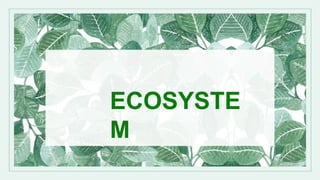
ECOSYSTEM -WPS Office.pptx
- 1. ECOSYSTE M
- 2. What is ecosystem? An ecosystem is a community of living things that interact with each other and with the physical world.
- 3. o The plants and animals within each ecosystem interact with each other and the non-living elements of the ecosystem like climate, precipitation, and soil.
- 4. o An ecosystem can be very small such as a puddle or under a rock. o It can also be as big as an ocean or a desert.
- 5. o The balance of an ecosystem is important. All things must work together to provide a good living environment. For example, if there is not enough water, plants and animals will die and the ecosystem will not exist.
- 6. Examples of Ecosystems o Desert o Arctic Tundra • Rainforest o Ocean o African Savanna o Swamp
- 7. DESERT • is the study of interactions between both biotic and abiotic components of desert environments. • a desert ecosystem is defined by interaction between organisms, the climate in which they live, and any other non-living influences on the habitat.
- 8. ARCTIC TUNDRA Are treeless regions found in the Arctic and on the tops of mountains, where the climate is cold and windy, and rainfall is scant.
- 9. RAINFOREST • Is an area of tall, mostly evergreen trees and a high amount of rainfall • Rainforest are Earth's oldest living ecosystems with some surviving in their present form of at least 70 million years
- 10. OCEAN/ MARINE • Are the largest of the Earth's Aquatic ecosystems and exist in waters that have a high salt content. These systems contrast with fresh water ecosystems, which have a lower salt content.
- 11. AFRICAN SAVANNA • Is a tropical grassland w/ warm temperatures year around and seasonal rainfall. • The savanna characterized by grasses and small or disprsed trees, along w/ a diverse community of organisms that interact to form a complex food web.
- 12. SWAMP • are among the most valuable ecosystems on Earth. They act like giant sponges or reservoirs. When heavy rains cause flooding, swamps and other wetlands absorb excess water, moderating the effects of flooding. Swamps also protect coastal areas from storm surges that can wash away
- 13. Producers o A living thing that can make its own food. o Examples: Plants, Trees, Flowers
- 14. Consumers o A living thing that gets its food from eating other living things. • Example: Cow( herbivore), bear (omnivore),lion(Carnivore)
- 15. Decomposers o A living thing that breaks down other living things to get nutrients and energy. o Examples: Vultures eat dead animals. Worms and beetles eat dead decaying plants.
- 16. Population o A group of living things that live in the same place at the same time. o Example: many penguins live in the artic; many elephants live in the African Savanna
- 17. Community • When different populations live together in the same habitat and interact with each other. • Example: Elephants, giraffes, and zebras all live together in the Savanna.
- 18. An abiotic factor is a non-living part of an ecosystem that shapes its environment. In a terrestrial ecosystem, examples might include temperature, light, and water.
- 19. A biotic factor is a living organism that shapes its environment. In a freshwater ecosystem, examples might include aquatic plants, fish, amphibians, and algae.
- 20. A food chain describes how energy and nutrients move through an ecosystem. At the basic level there are plants that produce the energy, then it moves up to higher-level organisms like herbivores. After that when carnivores eat the herbivores, energy is transferred from one to the other.
- 21. A food web consists of all the food chains in a single ecosystem. Each living thing in an ecosystem is part of multiple food chains. Each food chain is one possible path that energy and nutrients may take as they move through the
- 22. Thank You
- 23. Quiz muna😜
- 24. 1.An __________ includes all living and non-living things in an environment. a. population b. niche c. abitotic d. ecosystem 2._______ are consumers that eat only meat. A.Herbivore B.Omnivore C.Carnivore 3.Which group do fungi(mushrooms), bacteria, and earthworms belong to? a. decomposers b. producerS c. herbivores d. omnivores 4..The feeding relationship from one organism to another in an ecosystem is known as a ___. a. producer b. food chain c. herbivore d. carnivore 5. All of the following are abiotic factors except. a. Plant B. Water c. Sunlight d. Temperature
- 25. 6.An organism that creates its own food is called 7.what kind of animal is a cow? 8.What are the seasons in The Arctic Tundra? 9. It is the oldest living ecosystems 10. Example of animal that lives in swamp
- 26. Answer key: 1.C 2.C 3.A 4.B 5.A 6. Herbivore 7.windy 8. Producer 9. Rainforest 10.